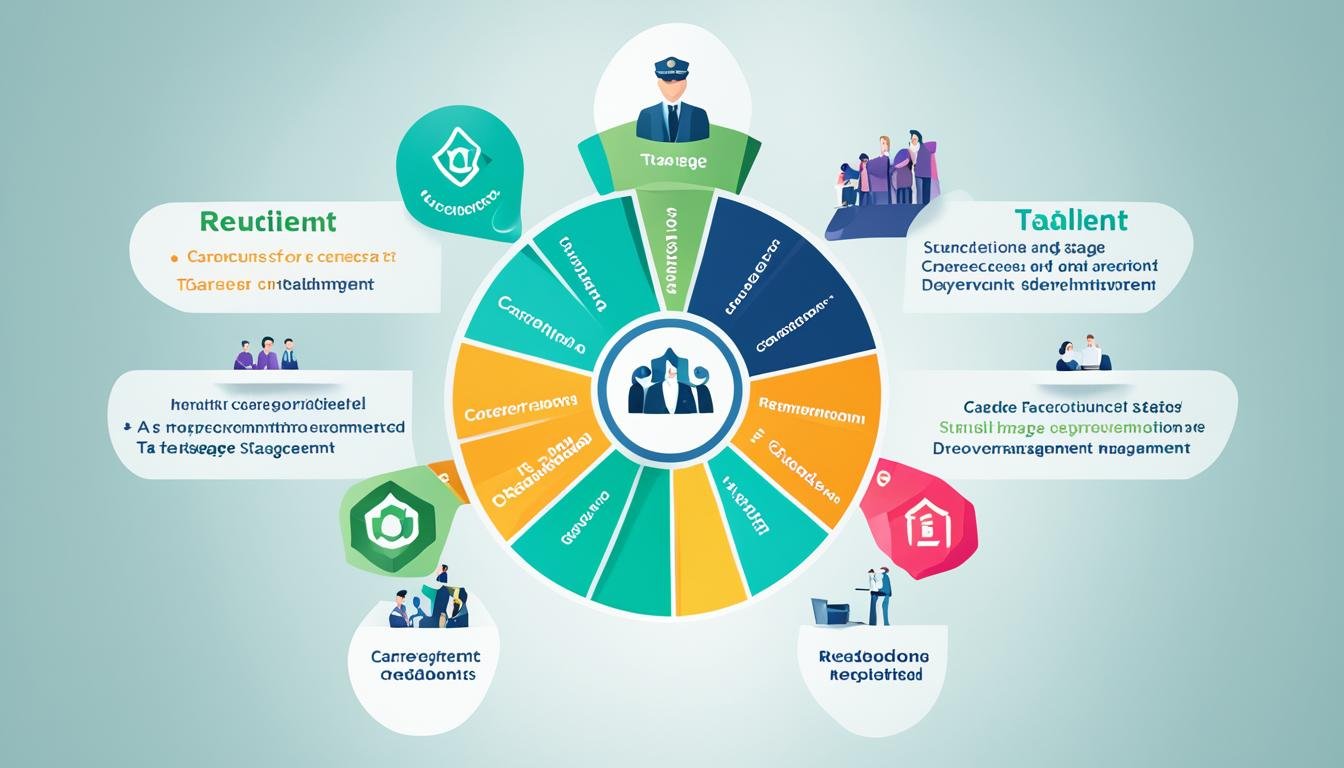Talent Management and Succession Planning in Irish Organizations
In the bustling corridors of an Irish tech firm’s Dublin headquarters, a quiet revolution was underway. The company had invested in a succession management solution. Its goal was to find and fix weak leadership spots for long-term growth. One morning, the CEO told a story at a team meeting that deeply moved everyone.
Just a year ago, the company met a potential crisis when a key leader suddenly left. This could have caused big problems, but the firm had prepared. Three candidates were ready to take the leadership role. The change happened smoothly, showing the power of being ready with a talent plan.
Irish firms see the need to link talent management with plan for the future. This way, when leaders change, it’s a smooth transition. They use tests and assessments to pick out the best people for jobs.
To make sure the right people are in the right places, companies often seek advice. They turn to people like Robert Ferry. He offers one-on-one sessions for €295+VAT which include advice notes afterward. Getting feedback from peers and seniors helps set the traits needed for leaders to succeed.
Key Takeaways
- Effective succession planning is critical for organizational resilience.
- Various tools and assessments help identify and develop future leaders.
- Proactive planning can mitigate disruptions during leadership transitions.
- Consulting experts can add immense value to your talent management strategy.
- Irish organizations are increasingly recognizing the importance of integrated talent management strategies.
Understanding Talent Management and Succession Planning
In today’s fast-paced business world, knowing how to manage talents and plan for the future is key. Over half of businesses in Ireland face high staff turnover, especially in tech. Using these strategies can really help businesses stay ahead.
What is Talent Management?
Talent Management means attracting, keeping, and growing your team to meet goals. It includes keeping employees learning and happy at work. Here’s what good Talent Management looks like:
- Recruitment: New hiring methods have made hiring 40% quicker.
- Development: Offering career growth and competitive pay cuts turnover by 30%. Those who pay well see a 25% boost in keeping their employees.
- Engagement: Keeping your team motivated and focused on the same goals builds loyalty.
What is Succession Planning?
Succession Planning isn’t just about replacing someone quickly. It’s about preparing a pool of talent so leadership change goes smoothly. Here’s what it involves:
- Identification: Spotting those with high potential already in your company.
- Development: Using tools like DISC Profile helps grow and assess new leaders.
- Preparation: Making sure future leaders are trained and ready, reducing risks.
The Importance of Integrating Both Practices
Bringing together Talent Management and Succession Planning helps keep employees interested and ready for bigger roles. This overall strategy does a few things:
- It links personal aims with the company’s, making everyone work towards the same goals.
- It shows employees there are long-term opportunities with the company, keeping them around.
- It keeps the business strong, ready to fill important jobs as needed.
Here’s a look at why this strategy is vital, based on some key stats:
| Metric | Talent Management | Succession Planning |
|---|---|---|
| Staff Turnover Reduction* | 30% | 25% |
| Increase in Hiring Speed | 40% | N/A |
| Employee Retention Increase | 25% | 25% |
| Companies Lacking Important Skills* | 90% | 81% |
By understanding and using these methods, a business can do better in tough markets. It’s about keeping the team growing, engaged, and moving forward in their careers.
Why Succession Planning is Critical for Organizational Success
Succession planning is vital in keeping an organization strong through change and surprise events. It ensures organizational continuity. A good plan looks ahead to understand leadership needs and prepares skilled people to step up.
Ensuring Continuity and Minimizing Disruption
This planning helps keep things running smoothly by getting ready for big job changes. It makes sure the company stays stable and efficient, even when leaders are changing. Big organizations, especially in healthcare and tech, use these plans to stay strong through transitions.
Developing Future Leaders
Succession planning is also about growing new leaders. It helps spot future leaders in the making. Then it gives them the right chances to develop. Surprisingly, more than 74% of leaders don’t feel ready for their roles. This shows how important it is to have a well-made plan.
Mitigating Risk and Adapting to Market Changes
Having a good plan is key for reducing risks. It makes businesses flexible, ready for unexpected industry shifts or losing key people. A study found that only about 53% of Irish family companies are really planning ahead. It means there’s a need to do better at managing these kinds of risks.
| Succession Planning Benefits | Data/Statistics |
|---|---|
| Reduces recruitment costs | Thanks to pre-developed talent pipelines |
| Minimizes attrition costs | Boosts employee motivation and engagement |
| Ensures smooth transitions | Essential for large organizations |
| Supports SMBs | Prepares for future skills and positions |
| Targets critical roles | Across various organizational levels |
Elements of an Effective Talent Management Strategy
An effective talent management strategy boosts a company’s performance. It makes sure that activities around managing talents match the company’s goals. A top strategy includes spotting key roles, setting up talent groups, and checking skills often.
Identifying Business-Critical Roles
First, teams must find roles that greatly influence success. These positions are key to the company’s health. Leaders need to mark out what makes a role critical.
They then make sure these roles are at the top of their plans. This helps the business keep running smoothly, avoiding problems, and preparing for change.
Creating Talent Pools
Next, it’s about grouping jobs by the skills they need. This way, when a critical role needs filling, there are already trained people ready. This plan ensures the business always has leaders coming up through its ranks.
It looks at what the business needs now and later. By doing this, every employee knows how they can help the company succeed. It builds a strong group of future leaders.
Regular Skill Gap Analysis and Training
Keeping an eye on skill gaps and filling them with targeted training is key. Nearly half of all employers check skills regularly. Unfortunately, few look ahead to what skills they’ll need next.
By always improving skills, companies prepare for the future. They make sure their team is ready for whatever comes, promoting a culture of growth and development.
Challenges in Implementing Succession Planning
Putting a good succession plan in place can be hard due to big amounts of talent data. It’s important to make sure the data is current and useful. This is because skills and job roles change all the time. The key is to keep all the talent data up to date. Doing this lets companies make smart decisions constantly, not just once in a while.
Data Management and Analysis
When it comes to Talent Database Management, focusing on using data is really important. Tools like Orgvue can make planning for the future easier. They show where your top talents are and how they are growing. This helps with creating plans that fit your needs now and later.
Keeping Talent Data Relevant and Up-to-Date
A good succession plan tries to balance having leaders who are very experienced with those who are new. But, updating talent data all the time is key to this balance:
- Regular Updates: Always update talent data to match any changes in jobs or skills.
- Data Validation: Check that the data is right from time to time. This stops you from using old or wrong info.
- Integrated Systems: Use systems that talk to each other. This keeps all the talent data across the company the same and reliable.
Here’s a table that shows how different parts of a good succession plan help:
| Key Aspects | Benefits |
|---|---|
| Prioritizing Critical Roles | Ensures that vital positions are always filled with capable individuals |
| Recruiting Competent Individuals | Brings in talent that contributes directly to organizational goals |
| Training and Developing Skills | Prepares employees for future leadership positions, fostering internal growth |
| Performance Assessment | Identifies high-potential employees and areas for improvement |
| Preparedness for Change | Ensures organizational continuity and stability during transitions |
Adopting Modern Succession Planning Techniques
It’s important for Irish companies to use new succession planning strategies to grow. These methods help companies stay agile and ready for changes in the market. By using technology and making succession a part of every day, businesses can find and grow their future leaders.
Utilizing Technology for Data-Driven Decisions
The use of technology is key in new succession planning. Tools like Orgvue help see the company’s structure and find future leaders with data. This lets companies plan better for who should lead the way next, reducing the chances of gaps in leadership.
Embedding Succession Planning in Business Processes
Integrating succession planning in regular tasks is also crucial today. By including it in reviews and development programs, companies make sure it matches their big goals. This keeps a steady flow of talent and makes the company ready for anything, staying ahead in the market.
| Succession Planning Elements | Brief Description |
|---|---|
| Technology Utilization | Using tools like Orgvue for data visualization and effective decision-making. |
| Structured Data | Leveraging structured data to identify and develop high-potential talent. |
| Embedded Processes | Incorporating succession planning into performance reviews and daily operations. |
| Organizational Agility | Ensuring the organization can swiftly adapt to changes in leadership needs. |
Talent Management and Succession Planning in Irish Organizations
Irish organizations are placing high value on talent management and succession planning. They see these as key to their success. There is a big push for leadership to be diverse and inclusive, which matches the overall company goals well.
Current Trends in Irish Organizations
The way people look at Talent Management in Ireland is changing. The country adopted the UK Corporate Governance Code in 2019. This makes companies talk more about how they choose leaders and plan ahead. It also makes them focus on having a clear path for everyone’s career, starting from the bottom up. This keeps talent coming and growing within the company. According to PwC, almost half of directors think at least one board member should be changed. This shows succession plans are really important. In Northern Ireland’s government, the Talent Management Strategy for 2023 to 2025 values preparation. It wants a skilled team ready for change and able to boost everyone’s confidence at work.
Case Studies of Successful Implementation
The success of Talent Management in Ireland is best seen in real-world examples. Some companies stand out because they use smart data to find and support new leaders. Others, like in studies by Odgers Berndtson, are good at dealing with hard times because they plan well. They keep their teams strong by sorting out who will fill key roles next. And they help the community grow too. These stories are proof that investing in your people pays off.
Retention Strategies to Support Succession Planning
Retaining your top employees is vital for a company’s success in planning for the future. Succession planning, making sure future leaders are ready, is key. It involves keeping high-potential employees happy and ready for bigger roles. As a result, companies should focus on keeping their talent happy, growing their skills, and having a strong group of future leaders.
For successful succession planning, it helps to use good ways to keep employees interested. Here are some tips:
- Make sure you pay well to keep top talent interested and staying.
- Show your team clear paths to grow within the company, as many would leave for better chances elsewhere.
- Invest in learning opportunities since a significant number would leave for chances to learn new skills.
- Build a workplace culture that’s uplifting and where every team member feels valued.
In Ceridian’s 2022 Executive Survey, 95% of leaders talked about how important it is to reconnect with past employees. Even with strong succession planning, a big part of hiring for leadership roles is done from outside. This shows that keeping your talent satisfied and engaged is crucial for smooth change when leadership switches.
Companies face the challenge of keeping their workforce’s future secure while being prepared to fill important roles from within. This means using smart strategies to keep and grow their best people. Such efforts make sure that the succession planning process is not only smooth but also sustainable.
| Retention Strategy | Benefit | Impact on Succession Planning |
|---|---|---|
| Competitive Compensation | Attracts and retains talent | Ensures a stable talent pool |
| Career Advancement Opportunities | Increases employee motivation | Promotes from within, reducing transition time |
| Continuous Learning Programs | Enhances employee skills | Prepares employees for leadership roles |
| Positive Organizational Culture | Fosters employee loyalty | Reduces talent attrition |
High-Potential Identification and Development
Spotting and growing high-potential talent is key for any company. It keeps the best people around and prepares them for leadership. Without this focus, top performers might look for opportunities elsewhere.
Defining High-Potential Criteria
It’s crucial to have a clear plan for finding high-potential employees. Mercer|Mettl’s assessment covers Mind, Drive, Agility, and Leadership. It’s a proven way to spot those with extraordinary skills.
The 9-Box Model aids in pinpointing employees’ potential with its nine performance categories. This method is precise and helps with future strategy by following the latest work trends.
Developing High-Potential Employees
Once you’ve found your future leaders, it’s important to help them grow. Coaching, training, and clear career paths are vital. These efforts prepare them for more senior roles.
Innovative tools like Virtual and 360-Degree Feedback provide detailed insights. They let companies make informed choices on employee development. This ongoing support creates a steady stream of well-prepared leaders.
Role of Leadership in Talent Management
An organization’s leadership is key to creating a strong talent culture. By focusing on leadership cultivation, they help managers grow their skills. This leads to the success of the whole organization.
Building a Strong Leadership Pipeline
Making a strong leadership pipeline is critical for growth. By spotting future leaders early and giving them tools, organizations get ready leaders. CEB’s study found that in groups with clear leadership styles, employees are 35% more engaged. High engagement means a more eager and effective workplace.
Leadership Development Programs
Having a mix of executive training programs helps leaders be better. These can feature:
- Mentoring: Guides from veterans to new managers.
- Workshops: Focused sessions on leading topics and challenges.
- Continuous Leadership Evaluation: Regular checks on development and readiness for bigger roles.
Many HR pros doubt Line Managers’ talent management skills. To tackle this, organizations aim to improve Line Managers’ skills. This shows HR is ready to solve problems and adapt.
| Aspect | Details |
|---|---|
| Employee Engagement Increase | 35% |
| Outdated Performance Models | 80% usage rate |
| Employee Identification Methods | Annual Reviews, Psychometric Testing, Evaluation Centers |
| HR Confidence in Line Managers | Low |
| Action Plans Implementation | Universal |
One big problem is the lack of a strong talent management definition. By honing in on leadership cultivation and executive training, organizations can build a clearer leadership path.
Conclusion
Strategic talent management and succession planning are key for any organization to stand strong and excel. Leading companies use these plans to boost revenue and cut employee turnover greatly. A strong talent strategy also makes employees more engaged, leading to better work and new ideas.
The best talent management includes finding great people, training them well, and helping them grow. Companies like GE, Unilever, and McDonald’s are changing how they develop leaders. They’re adapting to a more complex world, showing the importance of planning ahead.
Using new methods like combining in-office and remote work, and the latest tech, can keep top talent. Highlighting diversity, fairness, and valuing workers, plus learning from the past, helps companies in Ireland prosper. By following these steps, any company can ensure they are ready for whatever the future brings.
FAQ
What is Talent Management?
Talent Management is a focused method to get, keep, and grow employees to achieve goals. It puts the best people in the right places at the best times.
What is Succession Planning?
Succession Planning picks and grooms future leaders inside a company. It makes sure key roles don’t fall apart if someone leaves, helping solve retirements or sudden gaps well.
Why is integrating both Talent Management and Succession Planning important?
Meshing these two boosts how satisfied workers are and plans their career growth. It also shapes the next leaders, which powers up the whole company’s strength and success.
How does Succession Planning ensure continuity and minimize disruption?
It keeps the thread going by raising up new leaders through focused experiences. This keeps the gears turning, handling switch-ups in vital spots without a hiccup.
Why is developing future leaders crucial?
It’s key to keep a flow of strong leaders to jump on opportunities or tackle surprises. This makes sure the company steadily grows and stays strong.
How does Succession Planning mitigate risk and adapt to market changes?
A solid plan gets ready for talent gaps from big changes or people leaving. This prep makes adjusting to new conditions quick. It keeps the company strong and leading.
What are the first steps in an effective Talent Management strategy?
Early moves focus on spotting essential roles and readying pools of talent for them. It groups jobs by skill needs and preps people for key spots.
Why is regular skill gap analysis and training important?
Keeping an eye on what skills are lacking and neatly training fills these gaps. It keeps the staff sharp and ready for what’s ahead. This key work keeps the company growing smoothly.
What are the challenges in implementing Succession Planning?
It can be tricky, with lots of data to manage and keep current. Staying on top of the data’s quality helps make the best choices.
How can technology aid in Succession Planning?
Tools like Orgvue help make smart decisions with clear views of talent and structure. These tech tools make it easier to groom future leaders.
How can Succession Planning be embedded in daily business processes?
Weaving it into daily tasks, like reviews, lines up talent growth with big goals. This makes the leadership line stronger and the business more agile.
What are the current trends in Talent Management and Succession Planning in Ireland?
Ireland is now big on including all and building diverse leaders. It also spots future stars early and uses deep stats for smart talent handling.
Can you provide examples of successful implementation?
Good plans find leaders early, invest a lot in their growth, and rely on solid stats. These steps really toughen the company up and let it change fast when needed.
Why are retention strategies crucial to Succession Planning?
Keeping the best with sweet deals and chances to grow is vital. It keeps the leadership bench solid and steady, ready for tomorrow’s steps.
What criteria are used to identify high-potential employees?
Potential leaders stand out for their lead and think skills, and ability to adjust. Having clear benchmarks makes picking future leaders fair and effective.
How can high-potential employees be developed?
With crafted training, mentorship, and clear career paths, we prep them for leadership. This strengthens the organization’s upper layers for future needs.
What role does leadership play in Talent Management?
Leaders shape a culture that values and molds talent. They bolster the leadership line by teaching managers how to skillfully lead.
What are key components of Leadership Development Programs?
Such programs offer boss-level training, mentorship, and constant checks on leadership. Together, they support and grow the company’s future leaders.
Source Links
- Leadership Talent Management & Succession Planning with RFC
- Succession Planning
- Talent Management | Ireland Representatives | Harrison Assessments European Union
- What are the best practices for talent management in Ireland?
- Succession Planning – TTI Success Insights Ireland
- CIPD | Succession Planning | Factsheets
- The Succession Planning Process – Why is it important?
- CIPD | Talent management | Factsheets
- Understanding Talent Management and Implementing a Strategy
- Talent Management: Mastering the Basics for Success | ITD World
- Risks of Not Engaging in Succession Planning
- Ensuring effective succession planning in the Public Sector – Public Affairs Ireland | Training and Development | Conferences
- Odgers New Vision Overview
- How to Develop a Succession Planning Programs for Organizations | NNRoad
- Succession Planning for Next Generation Business Leaders
- JLAE 14(1
- What is succession planning? | HiBob
- Dayforce – Is succession planning the secret to employee retention?
- Effective succession planning: Developing future leaders and ensuring organisational continuity | Michael Page
- Succession planning
- Talent Assessment: High Potential Employee
- An Introductory Guide to Talent Assessment
- Definition of 9-Box Grid – Sloneek®
- Managing Talent within the Life Science Sector in Ireland
- The Role of Talent Management Comparing Medium-Sized and Large Companies – Major Challenges in Attracting and Retaining Talented Employees
- The Influence of Leadership Style, Talent Management and Succession Planning on Employee Retention.
- A Complete Guide To Talent Management | GrowthAcademyAsia
- VUCA: Why is Talent Management important for business agility
- How to Craft Your Business Case for Succession Planning








